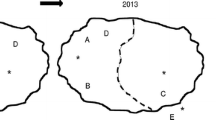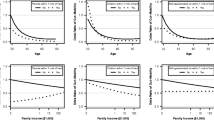Abstract
This article investigates why Americans who move have lower voter turnout than those who stay put. Two hypotheses are drawn from the political science literature. One emphasizes the need to register at one's new address in order to vote. The other locates the cause of lower turnout in the disruption of social connections that results from moving. By distinguishing those who change residences within their communities from those who move outside of their communities, I test the hypotheses. The findings show that both types of moves affect turnout. However, changing residences appears to be more important than changing communitites. Thus it appears that the explanation for the relationship between moving and turnout derives more from the need to register after moving than the disruption of social ties.
Similar content being viewed by others
REFERENCES
Brown, Thad A. (1988). Migration and Politics: The Impact of Population Mobilityon American Voting Behavior. Chapel Hill: University of North Carolina Press.
Brians, Craig Leonard (1997). Residential mobility, voter registration, and electoral participation in Canada. Political Research Quarterly 50: 215–227.
Conway, M. Margaret (1991). Political Participation in the United States, 2nd edition. Washington, DC: Congressional Quarterly Inc.
Highton, Benjamin (1997). Easy registration and voter turnout. Journal of Politics 59: 565–575.
Pomper, Gerald M., and Sernekos, Loretta A. (1991). Bake sales and voting. Society 28: 10–16.
Putnam, Robert D. (1995). Bowling alone, revisited. The Responsive Community 5: 18–33.
Rosenstone, Steven J., and Hansen, John Mark (1993). Mobilization, Participation, and Democracyin America. New York: Macmillan Publishing Company.
Sigelman, Lee, Roeder, Philip W., Jewell, Malcolm E., and Baer, Michael A. (1985). Voting and nonvoting: a multi-election perspective. American Journal of Political Science 29: 749–769.
Squire, Peverill, Wolfinger, Raymond E. and Glass, David (1987). Residential mobility and voter turnout. American Political Science Review 81: 45–65.
Teixeira, Ruy A. (1992). The Disappearing American Voter. Washington, DC: The Brookings Institution.
Timpone, Richard J. (1998a). Structure, behavior, and voter turnout in the United States. American Political Science Review 92: 145–158.
Timpone, Richard J. (1998b). Ties that bind: Measurement, demographics, and social connectedness. Political Behavior 20: 53–77.
Verba, Sidney, Schlozman, Kay Lehman, and Brady, Henry E. (1995). Voice and Equality: Civic Voluntarism in American Politics. Cambridge: Harvard University Press.
Wolfinger, Raymond E. (1993). Building a coalition to ease voter registration. Presented at the annual meeting of the American Political Science Association. Washington, DC.
Wolfinger, Raymond E., and Highton, Benjamin (1994). Can more efficient purging boost turnout? Paper presented at the Annual Meeting of the American Political Science Association. New York.
Wolfinger, Raymond E., and Rosenstone, Steven J. (1980). Who Votes? New Haven: Yale University Press.
Author information
Authors and Affiliations
Rights and permissions
About this article
Cite this article
Highton, B. Residential Mobility, Community Mobility, and Electoral Participation. Political Behavior 22, 109–120 (2000). https://doi.org/10.1023/A:1006651130422
Issue Date:
DOI: https://doi.org/10.1023/A:1006651130422




